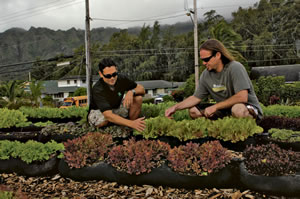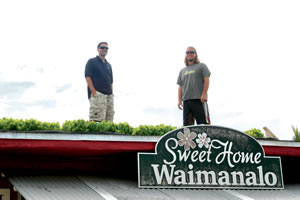Up On The Roof
A Waimanalo market-cafe leads the way with a rooftop garden, growing much of the produce for its daily needs

By .(JavaScript must be enabled to view this email address)
E-mail this story | Print this page | Archive | RSS

|
If we were facing Armageddon - and some say we already are at a crucial ecological threshold there are two guys you’d want around. With about 90 percent of our food imported, any disaster, natural or otherwise, that interrupts shipping would leave our supermarket shelves bare in just days. But it shouldn’t take a catastrophe for the community to start focusing on local, sustainable food production.
Meet Kevin Vaccarello and Alan Joaquin. Together, their ideas and skill sets make for a perfect storm of green thumb creativity. And they’ve begun putting those ideas to action. Or as Vaccarello says, they went from a “30,000-foot view to on-the-ground implementation.” He’s just a few feet off, actually, because it takes place on a roof.
Lately, as you drive along Kalanianaole Highway in Waimanalo, if you glance toward Vaccarello’s quaint little market and café, Sweet Home Waimanalo, you’ll see a sprightly burst of greens peeking up from the roof. Vaccarello is also the founder of Sustain Hawaii, an alliance of local businesses and nonprofits that focus on sustainable living. The café‘s rooftop farm is the combination of Vaccarello’s vision of self-sufficiency for the Islands and Joaquin’s 20 years of agricultural, horticultural and engineering experience.
“When I had my son, I wanted to feed him organic foods, and I had also lost my job as a pilot at Aloha Airlines,” says Joaquin. “So in 2008 I started aggressively creating what is now FarmRoof (farmroof.com), and Sweet Home Waimanalo is our first viable, commercial application.”
On April 19, in just six hours, the farm was installed (see video at sweethomewaimanalo.com/press). Years of trial and research went into Joaquin’s nifty setup. The result: several layers that protect the roof from soil and water used on the farm, yet allow air and rainwater to pass underneath, and a bio-filtration system around the entire perimeter to prevent erosion and to control sediment and nutrient runoff. The farm itself consists of seven rows of more than 20 different kinds of lettuces and herbs arugula, Ruby Streaks mustard, Flashy Trout Back romaine, Parris Island romaine, Bulls Blood beet, Red Russian kale, green and red oak leaf lettuce growing out of little modular planter socks that connect together for easy assembly and dismantlement. The rows are separated by mulch.
“The wood chips serve many purposes,” says Joaquin. “They retain moisture which allows for absorption of storm water to delay the amount of time it takes for the water to run off the roof. We don’t want to overtax our sewer system. Having green roofs downtown might have prevented the Ala Wai disaster.”
Their manner of speaking tends to the superlative, but spend a little time with Joaquin and Vaccarello and it’s easy to catch their enthusiasm. They’ve been mulling over these ideas for years and the seeds are finally coming to fruition. Everything they say makes sense and they’re out to prove it.

|
The FarmRoof is impeccably thought out. The mulch does more than just separate rows. It cools the ambient air temperature and encourages beneficial microbial life. The system produces double what farmers traditionally harvest and with precision delivery of water it uses 90 percent less water than conventional farming. Plants are kept healthy with the introduction of 70 different minerals and trace elements, and healthy plants do well at fighting off pests without the need for manual intervention. Joaquin’s invention is the only green roof farm in the world to be organically certified by the USDA (a long and involved process unto itself), so if the farm does run into bug problems, they employ counteractive methods that are gentle on the environment.
In just two days the seeds germinated and within the first six weeks Sweet Home had three harvests.
“We plant in cycles,” said co-owner of the cafe Joanne Kapololu. “We have one row planted and a week later we have the second and third row, and by the time we get to the last row, the first one is ready again. We have this constant supply and we’re always rotating.”
Kapololu, the café‘s menu wiz, says she aims for a mixture of colors, textures and tastes for the café‘s salads and other dishes.
But the café is only one part of Vaccarello’s move toward implementing an interconnected self-sufficient system, a sort of “experimentation station,” as he terms it. He’s built an extensive working model that focuses on maintaining clean energy, and kuleana for our aina and our water management.
“The first component is agriculture because everyone can relate to that. It’s tangible,” he explains. “My vision is 100 percent local. When we buy from elsewhere, all of our money goes out of state. With my five-acre farm in Waimanalo (Palaka Moon Farm) and the roof farm, I want to show how a sample feed system would look from soil to sale.
“An example of how the farms connects with the restaurant is we have a lot of green waste. All of our dish ware and cups are compostable, so we bring it to the farm and throw it in a pit and throw in some horse manure, which will break it down chemically. The food waste and meat scraps go into a different type of composting that’s for black soldier flies. The fly larvae becomes a feed stock for tilapia and chickens. Twenty-five hens will be producing about 175 eggs per week, which is enough for Sweet Home. The tilapia from our aquaponics system can go into fish tacos. Plus we’ll be producing a lot more greens in the aquaponic system as well. All of the waste from the restaurant produces the feedstock for the system.
“(With the homegrown ingredients we use at our café) it’s almost like we’re making a gourmet plate lunch but in a really funky rural space, so we can’t charge 20 or 30 bucks for a meal like you can in town. We have to eliminate as many of the costs as possible because there’s really no margins. It’s forced us to become super creative, but at the same time think of things much more systemically from a sustainability vantage point. That’s the fun part to really hone in on, but it’s also challenging because there’s costs for each of the components.”
Page 1 of 2 pages for this story 1 2 >
E-mail this story | Print this page | Comments (0) | Archive | RSS
Most Recent Comment(s):








